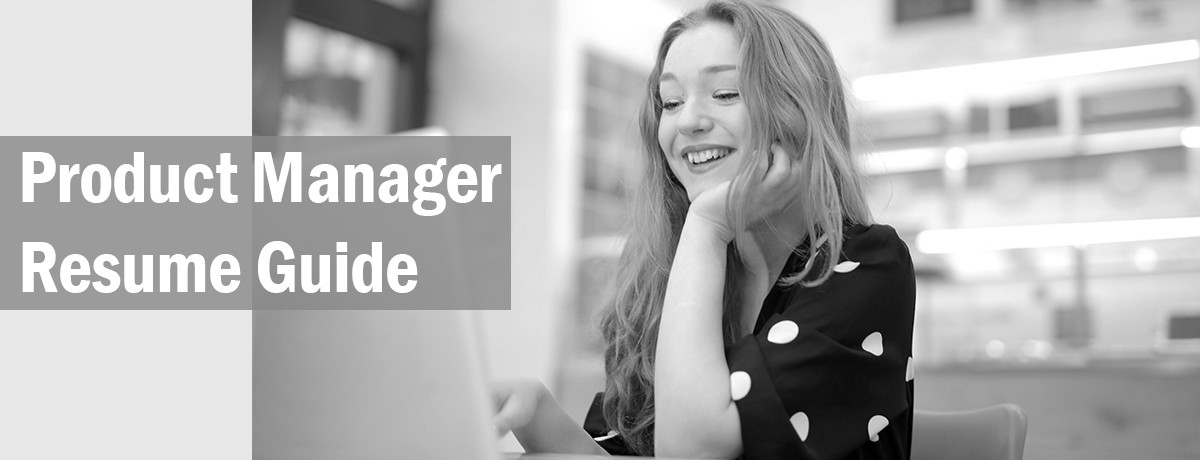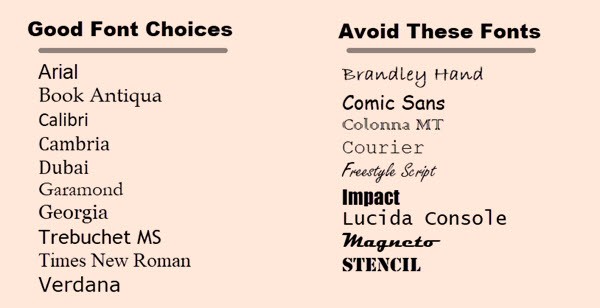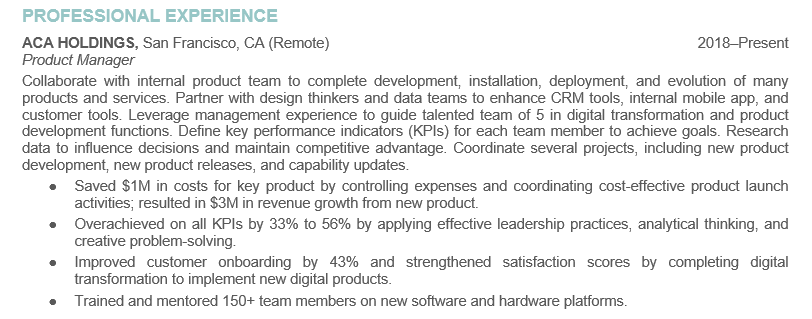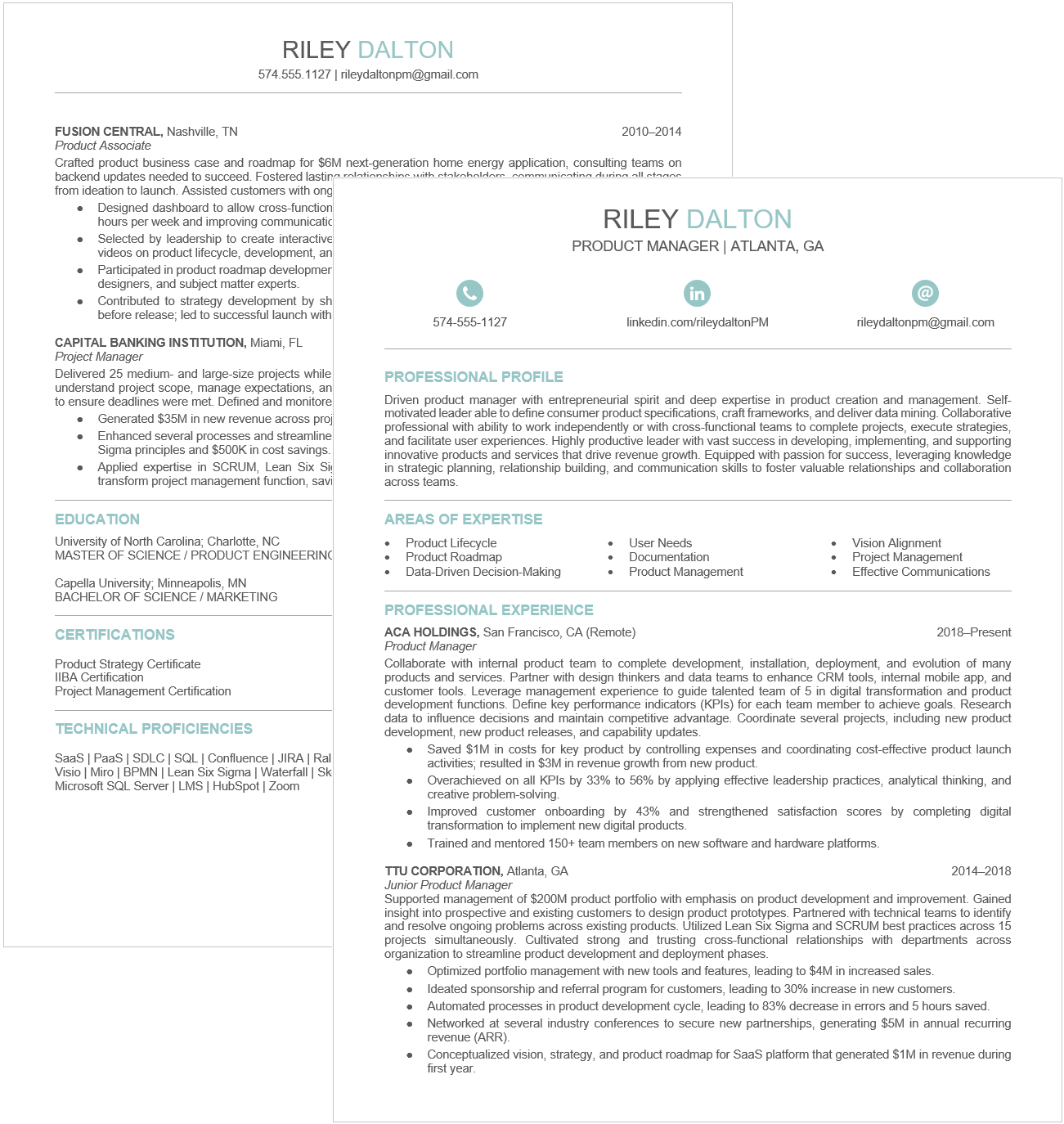Product Manager Resume

Are you an experienced product manager or maybe just someone ready for career advancement? Either way, it’s crucial to position your next job hunt with a professional resume for optimal results.
Everything you need to know about the product manager resume writing process can be found in this guide.
And if you find that you’d prefer to just download a full product manager resume template, you can purchase that template here.
About Product Manager Resumes
You’re a successful product manager and you know the value and skills you bring to an organization. You may bring it all to interviews and can speak about any success in your career history. But…how do you translate that into a resume? You know where you want your career to go and what jobs you want to target, but you may struggle with how to get your resume noticed by potential employers.
Before you start writing your resume, you need to take a step back and objectively look at your career. You want to create a short narrative that tells how you got to this point in your career and what accomplishments stand out among competitors.
Now that you understand this, you can research current industry trends. What attributes and skills are companies looking for? If you want to make a career shift or change, you should see what skills you have that are transferable in those roles.
As a product manager, you have a set of specific skills that should be clearly communicated on your resume. Potential employers expect you to have experience in managing projects, developing products, and working with cross-functional teams.
The next step after you know what you bring, what companies want, and the latest industry trends is to combine it all into a resume. It should be written in a concise and compelling manner that intrigues the reader to want to learn more about you. Resumes have several guidelines that you should follow regarding language, length, and information showcased.
Our team of career advancement experts are knowledgeable in these areas. If you find yourself struggling to write your resume after reading this guide, feel free to reach out and speak to one of our helpful professionals. We can help you create a resume that establishes your brand and optimizes your experience so you stand out with potential employers.

The Product Manager Resume in Context
Even the most qualified professionals are overwhelmed with the job search process. Not only do you have to navigate continuous industry changes, but you must also understand current technologies used by recruiters. You have to have a tactical approach to the job search process so your resume is noticed. Many companies use applicant tracking systems (ATS) to screen applicants, so understanding how to navigate the software is important.
Once you have developed a strong understanding of the job market and potential employer expectations, you can determine how to best present your work experience. When crafting your resume, you must consider how it reads to an outsider. Will they understand your career progression? Does this information convey what you delivered to the company? Does it paint a clear picture about how you can uniquely contribute to an organization?
A professional resume is compelling, clean, and concise. Here are a few best practices everyone should follow:
- Appealing and clean format
- Consistent spacing and format (font, margins, etc.)
- Showcase your value within the first few sentences
- Notable achievements should be easily recognizable
- Use data-driven evidence to support claims when possible
- Proofread to ensure an error-free document
- Eliminate pronouns and articles (a, an, the)
- Avoid overly technical language
- Spell out acronyms on the first use
Product manager resumes shouldn’t go past two pages or over 1,000 words. Many product managers have technical expertise or industry certifications, so it’s important to include these at the bottom of your resume.

Presenting Your Product Management Experience
he most successful resumes have a simple and elegant format. The internet is full of design-heavy formats that are pretty to look at, but aren’t very effective in the job search. Less is more with resumes. You want to say as much information as possible in as few words as possible.
Hiring managers and recruiters give resumes a few seconds of assessment before deciding if they will continue to read. It’s important your resume has accomplishments bulleted to make your achievements stand out and grab their attention in this review. A simple format helps to showcase these highlights in the best possible way. Your resume should be organized and efficient.
Professional resumes are clean, easy to read, and allow accomplishments to shine through words instead of a design. White space helps to create a clean aesthetic. Each section of the resume should be clearly labeled with headings, bold job titles, and clean fonts. Each experience section should have a concise description and bulleted achievements.
Professional resumes do not list hobbies or use photos, graphics, or excessive color. These distract from the content and can take away from your impact.

Next, we’ll discuss each section of the resume in more detail. This will tell you how to present and optimize your content.
Contact Information
Your contact information must be easy to find and accurate if you want to have a successful job search. Employers do not have the time to research how to contact you, so it’s important you use your current information and ensure it’s located at the top of the resume, like the below example:

You’ll notice a few things:
- Only your city and state are listed
- Select only one personal email address
- List your LinkedIn profile URL so they can learn more about you
- Include your personal phone number
Job Title and Summary
You craft your resume for the job you are seeking, not the jobs you have held in the past. The title at the top of the resume should align with the position you are applying for. You may need to customize this title if you are applying to roles that are different in scope. The ATS software scans resumes for the exact title and will give you a lower score if it’s not included on your document.
Given that hiring managers only give a resume a few seconds of time initially, you must show your value in the opening lines. Directly after the title is the executive summary. And the start of the executive summary is your unique value proposition (UVP). This is your elevator pitch that lets them know who you are as a professional and your greatest strengths and achievements.
An example UVP for a product manager is as follows:
Driven product manager with entrepreneurial spirit and deep expertise in product creation and management.
Using your UVP at the beginning, you’ll write an executive summary that is 3-5 sentences long. It should discuss key attributes that are unique to you and also aligned with the role you are targeting. You want to show what you contribute and how it drove success for your company.
An example executive summary for a product manager may look like this:
Driven product manager with entrepreneurial spirit and deep expertise in product creation and management. Self-motivated leader able to define consumer product specifications, craft frameworks, and deliver data mining. Collaborative professional with ability to work independently or with cross-functional teams to complete projects, execute strategies, and facilitate user experiences. Highly productive leader with vast success in developing, implementing, and supporting innovative products and services that drive revenue growth. Equipped with passion for success, leveraging knowledge in strategic planning, relationship building, and communication skills to foster valuable relationships and collaboration across teams.

The executive summary can be difficult to write because you have so much you want to convey but only have a few sentences to do so. This is where the job descriptions you researched are important. You want to highlight the key skills listed in the job descriptions, both hard and soft skills, so they know you have the abilities needed to succeed. You should use industry terms when possible. Avoid overly wordy or flashy language.
Keywords
Keywords are an important element of a professional resume. To pass the ATS software, you have to have the keywords that apply to that role. We can’t stress enough that even the most qualified professionals will be rejected by the ATS without the appropriate keywords. You can make sure your resume passes by optimizing the language in your resume with keywords.
Product managers are expected to have specific skills and attributes. Below, you’ll find a table of keywords common in your industry. This list is not exhaustive and doesn’t replace the need to do your own research.
Hard skills:
- Product management
- Product lifecycle
- Product roadmap
- Data-driven decision-making
- User needs assessment
- Documentation
- Vision alignment
- Strategic planning
- Project management
- Product development
- Product specifications
- Frameworks
- Data mining
- Strategy execution
- Team leadership
- User experience
- Revenue growth
Soft skills:
- Relationship-building
- Problem-solving
- Communications
- Cross-functional collaboration
- Self-motivation
- Productive
- Time-management
Areas of Expertise (Skills and Competencies)
From the list of keywords, you will pull the most important to use in the areas of expertise. This list is 6-12 bulleted items that show your industry skills. To make sure you pass ATS software, it’s important you match the exact phrasing from the job description.

Following the areas of expertise, you can choose to include a selected accomplishments section. This is up to you if you want to highlight 3-4 notable achievements. If you include this section, you mustn’t duplicate the same achievements later in the document.
- Saved $1M in costs for key product by controlling expenses and coordinating cost-effective product launch activities; resulted in $3M in revenue growth from new product.
- Overachieved on all KPIs by 33% to 56% by applying effective leadership practices, analytical thinking, and creative problem-solving.
- Improved customer onboarding by 43% and strengthened satisfaction scores by completing digital transformation to implement new digital products.
- Trained and mentored 150+ team members on new software and hardware platforms.
Employment History / Professional Experience
The professional experience section expands on your executive summary and UVP to show the specifics of your career history. Each role should show the evolution of your career in reverse chronological order. It’s important to limit the career history to the past 10-15 years to avoid age discrimination and only highlight your most relevant experience.
Under each position, you should list the following:
- Company name
- Location
- Years of employment (we recommend eliminating months for a cleaner look)
- A brief job description of daily responsibilities
- 3-8 bulleted achievements that show your contributions
When crafting the accomplishments, we recommend you follow the C-A-R method. This means you outline the challenge you faced, showcase the actions you took, and highlight the results it had on the company. If possible, you should include quantifiable data to back up these claims.
You want to avoid duplicate or repetitive content. So, if you achieved a similar accomplishment in two different roles, we recommend you only highlight one of them. You have limited real estate to highlight your entire career history, so you want to make sure you include only the most impactful information. Use active and compelling language that shows exactly what you did. Avoid phrases like responsible for, handled, or provided because more impactful verbs will paint a clearer picture. When writing your current job description, you need to use the present tense. When writing all bullets and past roles, you use past tense since they have already happened.

Some roles are important to show that fall out of the 10-15 year timeframe. If this happens, you can include an “additional experience” line with only the company, location, and title listed.
Education & Professional Development
Directly after your professional experience is where you highlight your education and credentials. For your education, you want to list degrees and where you obtained them. You do not include graduation years or GPAs in this section. You should also list relevant certifications and licenses in order of significance.

Additional Information
If you have space, you can include information about the following:
- Awards
- Professional Affiliations
- Publications
- Languages (if relevant to the desired position)
- Volunteer/Community Service
Product managers likely have technical proficiencies to include. You will put this after the education and only list those relevant to the job you are applying for.
Going into detail in these additional sections is not necessary. You should also avoid information that isn’t related to your career, like hobbies, as it doesn’t add value.


Complete Product Manager Resume Sample
It’s time to review your completed resume! You want to look at it from an aesthetic lens and go through it in detail. When reading, think like a hiring manager and ask yourself:
- Does the resume describe who I am concisely?
- Would I want to call this person?
- Does the resume use action words?
- Is the resume wordy or too long?
- Are there any formatting, spelling, or grammatical errors?
We recommend you have an industry peer and someone not in your industry review the resume at this point. Did you catch all errors? Is it understandable by someone who isn’t a product manager? Did you capture all relevant information?

Next Steps & Our Services
See Resume Writing Packages
We hope this guide gave you insight on how complex resume writing is. Now that you understand what goes into writing a professional resume, you probably realize why so many professionals like yourself seek help from a professional writer. Your time is valuable and a well-written resume can be the deciding factor in your next role.
PRW is a leading, full-service career advancement service. We work exclusively with professionals like you to help you get hired faster with higher salaries. We help you identify your unique brand and showcase your UVP so hiring managers have no doubt you are the best candidate for your next role.
Buy the Product Manager Resume Template
We are excited to assist you in landing your next interview for your dream job. We understand professional services aren’t for everyone, so we have, our product manager resume template available for download.